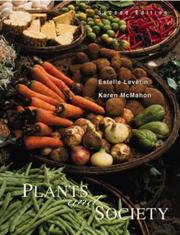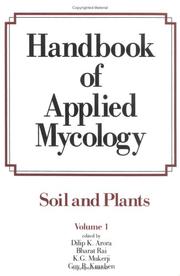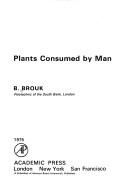| Listing 1 - 10 of 11 | << page >> |
Sort by
|
Book
ISBN: 0121403017 9780121403010 Year: 1982 Publisher: London : Academic Press,
Abstract | Keywords | Export | Availability | Bookmark
 Loading...
Loading...Choose an application
- Reference Manager
- EndNote
- RefWorks (Direct export to RefWorks)
Ecology. --- Microbiology --- Microbial ecology. --- Cultures and culture media. --- Microbiology. --- Ecology --- NUTRIENTS --- METALS --- RECOVERY --- FERMENTED FOOD --- BIOTECHNOLOGY --- HYDROGEN --- TRANSFERRING --- MICROORGANISMS --- COMMUNITIES --- MANUALS --- INTERACTIONS --- MIXTURES --- Microbial ecology

ISBN: 0697345521 Year: 1999 Publisher: Boston, MA ; London : WCB/McGraw-Hill,
Abstract | Keywords | Export | Availability | Bookmark
 Loading...
Loading...Choose an application
- Reference Manager
- EndNote
- RefWorks (Direct export to RefWorks)
ETHNOBOTANY --- PLANT CELLS --- PLANT ANATOMY --- PLANT PHYSIOLOGY --- LIFE CYCLES --- PLANTS --- FOOD PLANTS --- PLANT GENETICS --- PLANT SYSTEMATICS --- ECONOMIC PLANTS --- CAFFEINE --- HERBS --- SPICES --- MEDICINAL PLANTS --- POISONOUS PLANTS --- FUNGI --- FUNGI --- FUNGI --- ERGOT --- EDIBLE FUNGI --- ANTIBIOTICS --- MYCOTOXINS --- HALLUCINOGENIC FUNGI --- MEDICAL MYCOLOGY --- FIBRE PLANTS --- WOOD --- PAPERS --- ALLERGENIC PLANTS --- MONOGRAPHS --- HUMAN NUTRITION --- ENVIRONMENT --- FERMENTED BEVERAGES --- FERMENTED FOOD --- ETHNOBOTANY --- PLANT CELLS --- PLANT ANATOMY --- PLANT PHYSIOLOGY --- LIFE CYCLES --- PLANTS --- FOOD PLANTS --- PLANT GENETICS --- PLANT SYSTEMATICS --- ECONOMIC PLANTS --- CAFFEINE --- HERBS --- SPICES --- MEDICINAL PLANTS --- POISONOUS PLANTS --- FUNGI --- FUNGI --- FUNGI --- ERGOT --- EDIBLE FUNGI --- ANTIBIOTICS --- MYCOTOXINS --- HALLUCINOGENIC FUNGI --- MEDICAL MYCOLOGY --- FIBRE PLANTS --- WOOD --- PAPERS --- ALLERGENIC PLANTS --- MONOGRAPHS --- HUMAN NUTRITION --- ENVIRONMENT --- FERMENTED BEVERAGES --- FERMENTED FOOD
Book
ISBN: 9070351277 Year: 1996 Publisher: Baarn : Centraalbureau voor schimmelcultures,
Abstract | Keywords | Export | Availability | Bookmark
 Loading...
Loading...Choose an application
- Reference Manager
- EndNote
- RefWorks (Direct export to RefWorks)
Eumycetes --- fungi --- #abib:almm --- HACCP hazard analysis critical control point --- conserveren --- kiemgetal --- microbiële groei --- monsterneming (staalname) --- schimmels --- toxines --- voedingsmiddelenbederf --- General parasitology --- parasitologie --- voeding --- botanie --- chemische technologie --- 579.67 --- biologie --- kwaliteit --- microbiologie --- toegepaste microbiologie --- voedingsmiddelen --- voedingsmiddelenmicrobiologie --- Voedingsmicrobiologie --- FOOD MICROBIOLOGY --- FUNGI --- MYCOTOXINS --- FOOD PRESERVATIVES --- TAXONOMY --- FERMENTED FOOD --- FOOD DETERIORATION --- FOOD

ISBN: 0824783808 9780824783808 0824784359 9780824784355 082478491X 9780824784911 0824785010 9780824785017 0824785517 9780824785512 Year: 1991 Publisher: New York M. Dekker
Abstract | Keywords | Export | Availability | Bookmark
 Loading...
Loading...Choose an application
- Reference Manager
- EndNote
- RefWorks (Direct export to RefWorks)
Fungal diseases of plants. --- Mycorrhizas. --- Phytopathogenic fungi --- Wood-decaying fungi. --- Biological control. --- Mycorrihizae --- Wood-decaying fungi --- Fungal diseases of plants --- Fungal plant diseases --- Fungous diseases of plants --- Plant mycoses --- Mycoses --- Plant diseases --- Plants --- Decay fungi, Wood --- Wood --- Wood decay fungi --- Wood-destroying fungi --- Wood fungi --- Wood-rotting fungi --- Fungi --- Trees --- Biological control --- Effect of mycotoxins on --- Diseases and pests --- Microbiology --- Deterioration --- Carcinogenesis. --- Ecology. --- FUNGI --- FOOD DETERIORATION --- MOLDS --- FEEDS --- DETERIORATION --- MUSHROOMS --- BIOTECHNOLOGY --- FERMENTED BEVERAGES --- FERMENTED FOOD --- CULTIVATION --- UTILIZATION --- Aflatoxin --- Biosynthesis --- Genetic information --- Mycotoxins --- Toxicity --- MEDICAL MYCOLOGY --- ENTOMOGENOUS FUNGI --- HUMANS --- PARASITIC FUNGI --- NEMATOPHAGOUS FUNGI --- WOOD DESTROYING FUNGI --- PESTICIDES --- BIODEGRADATION --- MATHEMATICAL MODELS --- MYCORRHIZAS

ISBN: 012136450X Year: 1975 Publisher: London Academic press
Abstract | Keywords | Export | Availability | Bookmark
 Loading...
Loading...Choose an application
- Reference Manager
- EndNote
- RefWorks (Direct export to RefWorks)
581.6 --- 633 --- 634 --- 635 --- 581.199 --- Plants, Edible --- Botany, Economic --- Plants, Cultivated --- Cultivated plants --- Agricultural botany --- Botany, Agricultural --- Economic botany --- Edible plants --- Food plants --- 581.199 Physiology of fermentations --- Physiology of fermentations --- 635 Garden plants. Gardening --- Garden plants. Gardening --- 634 Horticulture generally --- Horticulture generally --- 633 Field crops and their production --- Field crops and their production --- 581.6 Applied botany. Use of plants. Technobotany. Economic botany --- Applied botany. Use of plants. Technobotany. Economic botany --- Botany, Economic. --- Plants, Cultivated. --- Plants, Edible. --- Plant and Crop Sciences. Crops -- Crops (General). --- Crops --- Picking --- Nonwood forest products --- Human feeding --- Plants, Useful --- Edible landscaping --- Agriculture --- Domestication --- Plant introduction --- Biology, Economic --- Human-plant relationships --- ALCOHOLIC BEVERAGES --- FERMENTED FOOD --- MASTICATION --- PLANTS --- NARCOTICS --- BEVERAGE PLANTS --- PLANT EXTRACTS --- NUTS --- FRUITS --- VEGETABLES --- CEREALS --- FOOD PLANTS
Book
Year: 2021 Publisher: Basel, Switzerland MDPI - Multidisciplinary Digital Publishing Institute
Abstract | Keywords | Export | Availability | Bookmark
 Loading...
Loading...Choose an application
- Reference Manager
- EndNote
- RefWorks (Direct export to RefWorks)
Written by experts in the field of table olives, this book is a source of recent research advances on the characterization and processing of table olives. Research papers are provided relating to the characterization of their composition of volatiles and the sensory profile; mineral composition and bioavailability; changes in bioactive components (chlorophylls) by processing; and new strategies to reduce sodium and additives for stabilizing the organoleptic properties and avoiding defects in table olives. Other research papers are included in relation to microbiological and chemical changes in table olives during spontaneous or controlled fermentation employing different cultivars, and the optimized use of starter cultures for the improvement of the different fermentative processes. In addition, this book includes an overview of the main technologies used for olive fermentation, including the role of lactic acid bacteria and yeasts characterizing this process, and of the processing and storage effects on the nutritional and sensory properties of table olives.
Technology: general issues --- table olives --- starter cultures --- GC-MC analysis --- volatile composition --- bitterness --- consumer willingness to pay --- descriptive sensory analysis --- green-olive flavor --- “Manzanilla” cultivar --- pit hardening --- regulated deficit irrigation --- panel performance --- panelist --- black ripe table olives --- sensory descriptors --- sensory profile --- fermentation --- microbiological changes --- organoleptic --- physicochemical --- Clostridium --- logistic regression --- acid-adapted strains --- predictive models --- fermented vegetables --- undefined biodiverse starters --- autochtonous cultures --- lactic acid bacteria --- Lactobacillus pentosus --- Tonda di Cagliari --- table olive --- phenolic compounds --- oleuropein --- LAB --- yeasts --- fermented food --- probiotic table olives --- non-dairy probiotics --- sodium --- potassium --- calcium --- magnesium --- iron --- phosphorus --- darkened by oxidation olives --- Miller’s protocol --- Crews’ protocol --- post-digest re-extraction --- minerals --- sea salt --- PGI --- iodized salt --- functional food --- composition --- nutritional properties --- polyphenols --- sensory analysis --- chlorophyll --- pigments --- allomerization --- alkaline treatment --- phytyl-chlorin --- phytyl-rhodin --- Bella di Cerignola --- brines --- microbiological quality --- user-friendly spreadsheet --- producers --- bioaccessibility --- mineral nutrients --- pigment composition
Book
Year: 2021 Publisher: Basel, Switzerland MDPI - Multidisciplinary Digital Publishing Institute
Abstract | Keywords | Export | Availability | Bookmark
 Loading...
Loading...Choose an application
- Reference Manager
- EndNote
- RefWorks (Direct export to RefWorks)
This book covers the latest development of bioprocess technology including theoretical, numerical, and experimental approaches in biotechnology as well as green technology that bridge conventional practices and Industry 4.0. Bioprocessing is one of the key factors in several emerging industries of biofuels, used in the production of biogas, bioethanol, and biodiesel; industrial enzymes; waste management through biotechnology; new vaccines; and many more. It is hoped that the novel bioprocess and green biotechnologies presented in this book are useful in assisting the global community in working towards fulfilling the Sustainable Development Goals (SDG) of the United Nations.
Technology: general issues --- extraction --- leaf --- liquid biphasic flotation --- polygonum --- protein --- date fruits --- proximate analysis --- physico-chemical characteristics --- date sugar --- phytoconstituents --- amino acids --- biomaterials --- Ficus carica --- diabetes mellitus --- proteomics --- sperm quality --- bioeconomy --- bioprocesses --- applications --- policy --- social welfare --- sustainability --- nanofiltration --- lipase --- Fusarium heterosporum --- fatty acid methyl ester --- electronics package --- induction heating --- magnetic field --- electric field --- TM110 single-mode cavity --- solder --- eddy current --- GABA --- fermented food --- functional food --- non-protein amino acid --- soy sauce fermentation --- lignocellulosic biomass --- holocellulose --- CMC --- degree of substitution --- excipient --- non-edible --- oil --- biodiesel production --- fuel --- Lactobacillus isolation --- lag phase --- bacteria sequencing --- breast milk --- chitosan --- co-loaded nanoparticles --- hydrophobic modification --- l-ascorbic acid --- thymoquinone --- sustainable supply chain management (SSSCM) --- social sustainability --- qualitative research --- Pakistan --- biohydrogen production --- immobilised cells --- entrapment --- alginate --- activated carbon --- carbon dioxide --- culture media --- microorganism --- optimization --- plant growth promoting rhizobacteria --- oil palm seedlings nursery --- biofertilizers --- chemical fertilizer --- n/a --- sago hampas --- amylase --- cellulase --- substrate feeding --- saccharification --- biomass --- waste cooking oil --- green fuel --- biodiesel --- heterogeneous catalyst --- deoxygenation
Book
Year: 2021 Publisher: Basel, Switzerland MDPI - Multidisciplinary Digital Publishing Institute
Abstract | Keywords | Export | Availability | Bookmark
 Loading...
Loading...Choose an application
- Reference Manager
- EndNote
- RefWorks (Direct export to RefWorks)
Written by experts in the field of table olives, this book is a source of recent research advances on the characterization and processing of table olives. Research papers are provided relating to the characterization of their composition of volatiles and the sensory profile; mineral composition and bioavailability; changes in bioactive components (chlorophylls) by processing; and new strategies to reduce sodium and additives for stabilizing the organoleptic properties and avoiding defects in table olives. Other research papers are included in relation to microbiological and chemical changes in table olives during spontaneous or controlled fermentation employing different cultivars, and the optimized use of starter cultures for the improvement of the different fermentative processes. In addition, this book includes an overview of the main technologies used for olive fermentation, including the role of lactic acid bacteria and yeasts characterizing this process, and of the processing and storage effects on the nutritional and sensory properties of table olives.
table olives --- starter cultures --- GC-MC analysis --- volatile composition --- bitterness --- consumer willingness to pay --- descriptive sensory analysis --- green-olive flavor --- “Manzanilla” cultivar --- pit hardening --- regulated deficit irrigation --- panel performance --- panelist --- black ripe table olives --- sensory descriptors --- sensory profile --- fermentation --- microbiological changes --- organoleptic --- physicochemical --- Clostridium --- logistic regression --- acid-adapted strains --- predictive models --- fermented vegetables --- undefined biodiverse starters --- autochtonous cultures --- lactic acid bacteria --- Lactobacillus pentosus --- Tonda di Cagliari --- table olive --- phenolic compounds --- oleuropein --- LAB --- yeasts --- fermented food --- probiotic table olives --- non-dairy probiotics --- sodium --- potassium --- calcium --- magnesium --- iron --- phosphorus --- darkened by oxidation olives --- Miller’s protocol --- Crews’ protocol --- post-digest re-extraction --- minerals --- sea salt --- PGI --- iodized salt --- functional food --- composition --- nutritional properties --- polyphenols --- sensory analysis --- chlorophyll --- pigments --- allomerization --- alkaline treatment --- phytyl-chlorin --- phytyl-rhodin --- Bella di Cerignola --- brines --- microbiological quality --- user-friendly spreadsheet --- producers --- bioaccessibility --- mineral nutrients --- pigment composition
Book
Year: 2021 Publisher: Basel, Switzerland MDPI - Multidisciplinary Digital Publishing Institute
Abstract | Keywords | Export | Availability | Bookmark
 Loading...
Loading...Choose an application
- Reference Manager
- EndNote
- RefWorks (Direct export to RefWorks)
This book covers the latest development of bioprocess technology including theoretical, numerical, and experimental approaches in biotechnology as well as green technology that bridge conventional practices and Industry 4.0. Bioprocessing is one of the key factors in several emerging industries of biofuels, used in the production of biogas, bioethanol, and biodiesel; industrial enzymes; waste management through biotechnology; new vaccines; and many more. It is hoped that the novel bioprocess and green biotechnologies presented in this book are useful in assisting the global community in working towards fulfilling the Sustainable Development Goals (SDG) of the United Nations.
extraction --- leaf --- liquid biphasic flotation --- polygonum --- protein --- date fruits --- proximate analysis --- physico-chemical characteristics --- date sugar --- phytoconstituents --- amino acids --- biomaterials --- Ficus carica --- diabetes mellitus --- proteomics --- sperm quality --- bioeconomy --- bioprocesses --- applications --- policy --- social welfare --- sustainability --- nanofiltration --- lipase --- Fusarium heterosporum --- fatty acid methyl ester --- electronics package --- induction heating --- magnetic field --- electric field --- TM110 single-mode cavity --- solder --- eddy current --- GABA --- fermented food --- functional food --- non-protein amino acid --- soy sauce fermentation --- lignocellulosic biomass --- holocellulose --- CMC --- degree of substitution --- excipient --- non-edible --- oil --- biodiesel production --- fuel --- Lactobacillus isolation --- lag phase --- bacteria sequencing --- breast milk --- chitosan --- co-loaded nanoparticles --- hydrophobic modification --- l-ascorbic acid --- thymoquinone --- sustainable supply chain management (SSSCM) --- social sustainability --- qualitative research --- Pakistan --- biohydrogen production --- immobilised cells --- entrapment --- alginate --- activated carbon --- carbon dioxide --- culture media --- microorganism --- optimization --- plant growth promoting rhizobacteria --- oil palm seedlings nursery --- biofertilizers --- chemical fertilizer --- n/a --- sago hampas --- amylase --- cellulase --- substrate feeding --- saccharification --- biomass --- waste cooking oil --- green fuel --- biodiesel --- heterogeneous catalyst --- deoxygenation
Book
Year: 2021 Publisher: Basel, Switzerland MDPI - Multidisciplinary Digital Publishing Institute
Abstract | Keywords | Export | Availability | Bookmark
 Loading...
Loading...Choose an application
- Reference Manager
- EndNote
- RefWorks (Direct export to RefWorks)
Written by experts in the field of table olives, this book is a source of recent research advances on the characterization and processing of table olives. Research papers are provided relating to the characterization of their composition of volatiles and the sensory profile; mineral composition and bioavailability; changes in bioactive components (chlorophylls) by processing; and new strategies to reduce sodium and additives for stabilizing the organoleptic properties and avoiding defects in table olives. Other research papers are included in relation to microbiological and chemical changes in table olives during spontaneous or controlled fermentation employing different cultivars, and the optimized use of starter cultures for the improvement of the different fermentative processes. In addition, this book includes an overview of the main technologies used for olive fermentation, including the role of lactic acid bacteria and yeasts characterizing this process, and of the processing and storage effects on the nutritional and sensory properties of table olives.
Technology: general issues --- table olives --- starter cultures --- GC-MC analysis --- volatile composition --- bitterness --- consumer willingness to pay --- descriptive sensory analysis --- green-olive flavor --- “Manzanilla” cultivar --- pit hardening --- regulated deficit irrigation --- panel performance --- panelist --- black ripe table olives --- sensory descriptors --- sensory profile --- fermentation --- microbiological changes --- organoleptic --- physicochemical --- Clostridium --- logistic regression --- acid-adapted strains --- predictive models --- fermented vegetables --- undefined biodiverse starters --- autochtonous cultures --- lactic acid bacteria --- Lactobacillus pentosus --- Tonda di Cagliari --- table olive --- phenolic compounds --- oleuropein --- LAB --- yeasts --- fermented food --- probiotic table olives --- non-dairy probiotics --- sodium --- potassium --- calcium --- magnesium --- iron --- phosphorus --- darkened by oxidation olives --- Miller’s protocol --- Crews’ protocol --- post-digest re-extraction --- minerals --- sea salt --- PGI --- iodized salt --- functional food --- composition --- nutritional properties --- polyphenols --- sensory analysis --- chlorophyll --- pigments --- allomerization --- alkaline treatment --- phytyl-chlorin --- phytyl-rhodin --- Bella di Cerignola --- brines --- microbiological quality --- user-friendly spreadsheet --- producers --- bioaccessibility --- mineral nutrients --- pigment composition --- table olives --- starter cultures --- GC-MC analysis --- volatile composition --- bitterness --- consumer willingness to pay --- descriptive sensory analysis --- green-olive flavor --- “Manzanilla” cultivar --- pit hardening --- regulated deficit irrigation --- panel performance --- panelist --- black ripe table olives --- sensory descriptors --- sensory profile --- fermentation --- microbiological changes --- organoleptic --- physicochemical --- Clostridium --- logistic regression --- acid-adapted strains --- predictive models --- fermented vegetables --- undefined biodiverse starters --- autochtonous cultures --- lactic acid bacteria --- Lactobacillus pentosus --- Tonda di Cagliari --- table olive --- phenolic compounds --- oleuropein --- LAB --- yeasts --- fermented food --- probiotic table olives --- non-dairy probiotics --- sodium --- potassium --- calcium --- magnesium --- iron --- phosphorus --- darkened by oxidation olives --- Miller’s protocol --- Crews’ protocol --- post-digest re-extraction --- minerals --- sea salt --- PGI --- iodized salt --- functional food --- composition --- nutritional properties --- polyphenols --- sensory analysis --- chlorophyll --- pigments --- allomerization --- alkaline treatment --- phytyl-chlorin --- phytyl-rhodin --- Bella di Cerignola --- brines --- microbiological quality --- user-friendly spreadsheet --- producers --- bioaccessibility --- mineral nutrients --- pigment composition
| Listing 1 - 10 of 11 | << page >> |
Sort by
|

 Search
Search Feedback
Feedback About UniCat
About UniCat  Help
Help News
News